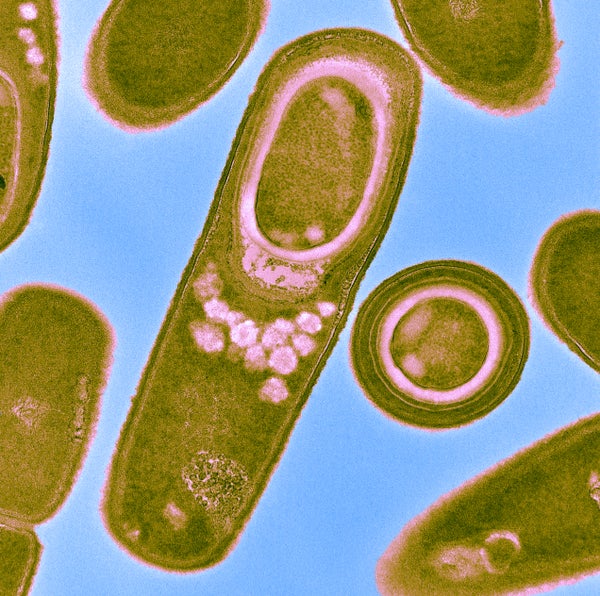
To Find Life on Mars, Make Microbes Wiggle
www.scientificamerican.com
February 5, 20254 min readTo Find Life on Mars, Make Microbes WiggleCould tiny swimming microbes help us unlock the mysteries of extraterrestrial life?By Gayoung Lee edited by Lee BillingsA color-enhanced microscopic view of Bacillus subtilis bacteria, rod-shaped extremophile microbes commonly found in soil and in the guts of cows and humans. Science SourceThe latest advance in the search for extraterrestrial life could come from the wiggles of swimming microbesmicroscopic single-celled organisms that are abundant in just about every nook and cranny of Earth.Microbes are found throughout our planets biosphere because many of them are able to flourish under very harsh conditions that apparently preclude larger, more complex life-forms. And that remarkable resilience is why astrobiologists are so keen to study them. If, for instance, microbes can thrive in a lake buried beneath Earths south polar ice cap, maybe similar organisms could exist in glancingly similar extraterrestrial environments, such as the mysterious ice-covered ocean of Jupiters moon Europa or water-logged regions of Marss subsurface. But the trick isnt to merely show that alien life might exist in such places but rather to confirm that it doeswhich requires detecting its presence in the first place. Most interplanetary life-detection experiments have involved looking for chemical tracersbiosignaturesthat otherworldly microbes might create in their environments as a by-product of their metabolism. Now, however, a new approach based on microbes self-guided movement, or motility, may be in reach.Historically, testing for microbial motility has been an expensive and time-consuming task, ill-suited for incorporation into robotic space missions. Thats prompted a team of German astrobiologists to devise a simpler, more cost-efficient way to check for motility, an approach that they have detailed in a study published on February 6 in the journal Frontiers in Astronomy and Space Sciences.On supporting science journalismIf you're enjoying this article, consider supporting our award-winning journalism by subscribing. By purchasing a subscription you are helping to ensure the future of impactful stories about the discoveries and ideas shaping our world today.In their study, the researchers focused on three types of microbesBacillus subtilis, Pseudoalteromonas haloplanktis and Haloferax volcaniiall of which are known extremophiles, or organisms that can survive extreme temperatures, pressures or chemical conditions. Their experiment was simple: Could they prompt the microbes to swim toward a nutrient source in a detectable, repeatable way? To do this, they placed microbe-packed water droplets on one partition of a two-chambered microscopic slide. On the other side lay an aqueous solution that was rich with L-serine, an amino acid that is critical for protein synthesis and cell proliferation. When they tested each type of microbe in separate three-hour experimental runs, the researchers could see all three species become motile and migratory: the microbes swam from their initial chamber to form blobs inside the chamber with L-serine. This tendency of organism to drift toward or away from the presence of certain chemicals is called chemotaxis.In the case of the organisms used in this experiment, the idea of chemotaxis is that microbes can sense [and move to] molecules that might be useful for them, especially for metabolism, explains the studys lead author Max Riekeles, a Ph.D. student at the Technical University of Berlin. With our specific setup, we wanted to make the visual and computational aspects [of studying chemotaxis] simpler.The trouble with past chemotaxis-based methods for prompting and monitoring microbial motility is that its hard to set up chemical gradients that are reliable, stable and predictable, says Christian Lindensmith, an astrobiologist at NASAs Jet Propulsion Laboratory. Furthermore, watching motility is difficult because microscopes have a small field of view and microbes can move for other, entirely external reasons, such as thermal mixing and inertial drift. Its just very trickylike youre running this microscopic zoo, he adds.A gel membrane that separated the new experiments two chambers proved crucial for minimizing such difficulties by greatly reducing the microbes options for motion. This semipermeable gel essentially acted as a one-way barrier that allowed organisms from one side to pass through relatively quickly while it also slowed L-serines seepage to the other sidethus maintaining the microbes motivation to move. The setup was a good choice, says Jay Nadeau, an astrobiologist and a physics professor at Portland State University, because it made discerning the microbes motility much easierall the more so because the barrier kept the microbes on the L-serine side once they entered.Such technical advances could be hugely beneficial for future life-seeking space missions, say Nadeau and Lindensmith, both of whom were formerly Riekeless colleagues but were uninvolved with the new study. One of the real problems with doing something like this on another worldespecially one thats going to be very cold, like Europais: What happens if those [alien] organisms swim really, really slowly? Nadeau explains. Well, in that case you might need to leave them for a week or more and then come back.Using the new method, scientists could merely check for any microbes in the nutrient-filled chamber rather than constantly monitoring the system for conspicuously cavorting microbes. So that part is easy, Lindensmith says. The hard part is figuring out what to put on the other side as bait. Although Earths homegrown life may love L-serine and other similarly fundamental foodstuff, theres no guarantee such substances would be appealing to alien organisms with a different biochemistry.Even assuming that lifes menu of nutrients is identical across the cosmos, however, other hurdles remain before this method could manifest in some sort of measuring device on an actual interplanetary astrobiology mission. For Riekeles, the next challenge is not only the need to further refine this technique with new, more extensive experiments but also the matter of engineering and testing with different kinds of microbes and amino acids.One of the goals [of astrobiology] is to go to [other worlds] and look for microorganisms, but in the meantime theres so much we can do on Earth that will give us massive insights, Nadeau says. And this new method for microbial sorting is a great example of simple but crucial work for future efforts to build upon.You dont know whats going to be out there [in space], Lindensmith saysso diversifying your tools and techniques to scrutinize life right here on our own planet is an important first step. We have to be able to do all of that kind of stuff on Earth before we can meaningfully do it on other planets.
0 Comments
·0 Shares
·0 Reviews



